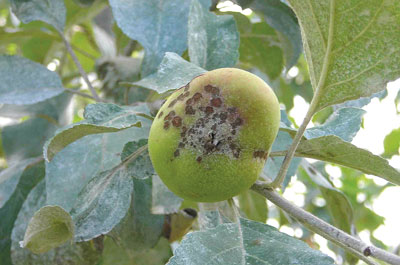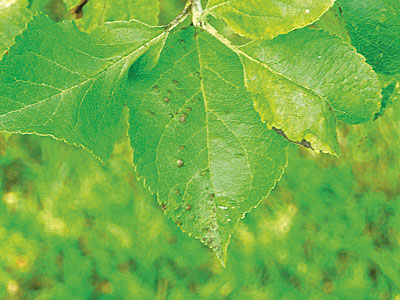 |
| Scab on an apple. Photo by C.J. Walke. |
 |
| Scab lesions on apple leaves. Photo by C.J. Walke. |
By C. J. Walke
For organic apple growers in the Northeast, one of the major disease challenges is managing apple scab in orchard trees. Apple scab, caused by the fungus Venturia inaequalis, can severely affect unsprayed or unmanaged trees, leading to heavy fruit loss and potential tree death if unchecked. The severity of apple scab led to breeding of scab-resistant varieties over the past half century, but in recent years some of these scab-resistant varieties are losing resistance and contracting the disease.
Breeding History
Most of the available scab-resistant apple varieties grew from collaborative breeding work by Purdue University, Rutgers University and the University of Illinois, referred to as the PRI apple breeding program, which began in the late 1940s. Researchers had found a crabapple tree native to Japan and East Asia, Malus floribunda 821, that showed resistance to apple scab. They isolated the resistant Vf gene and began breeding the Vf gene into commercial apple cultivars. (For breeding info see www.hort.purdue.edu/newcrop/pri/breeding.html)
Since 1970, nearly 50 scab-resistant cultivars have been released and are available to growers. Most initially held plant patents – now expired – and the majority contain the Vf gene. Most PRI cultivars contain the letters “pri” in the name, such as ‘Prima’, ‘Priscilla’, ‘Enterprise’ and ‘William’s Pride’. The New York State Agricultural Experiment Station (NYSAES) has also developed scab-resistant cultivars that contain the Vf gene, such as ‘Liberty’ and ‘Freedom’.
Resistance in Flux
When speaking of loss of resistance, two types of loss may occur – resistance of the fungus to fungicides, and resistance of trees to the fungus. They are different and can easily be misrepresented.
One type occurs when the scab fungus becomes resistant to a specific fungicide or class of fungicides, and that product no longer effectively controls the disease. (Fungicides are often classified by their mode of action – how the fungicide attacks the fungus – so if a fungus develops resistance to a specific fungicide’s mode of action, then it typically develops resistance to all fungicides in that class.) Researchers believe that often, when an organism, such as the scab fungus, adapts to form resistance to certain stimuli, such as a fungicide, that adaptation will make the organism vulnerable in some other capacity. That has not been the case with apple scab. The literature shows that scab has developed resistance to common fungicides but has not displayed any type of vulnerability to other environmental conditions or stimuli.
The other type is when the disease resistance of a specific plant or cultivar weakens, making that cultivar susceptible to infection. This situation is more complex, because it may not be obvious whether the situation is caused by adaptations of the scab fungus to overcome a fungicide or to breakdown over time of the cultivar’s resistance to the pathogen. Also, other environmental factors could be at play.
Either way, apple varieties that were scab-free for decades are, in some cases, starting to fall prey to Venturia inaequalis.
According to Janna Beckerman, iI thinn 1993, a German orchard first showed the presence of apple scab on its ‘Prima’ trees. Researchers collected samples of the pathogen but were not able to infect M. floribunda 821 or other scab-resistant cultivars with the samples. However, in 1994, scab was found on M. floribunda 821 in England, and in 2007 on M. floribunda 821 in Indiana, Illinois and Ohio. In 2008, growers reported scab on ‘Pristine’, ‘Pixie Crunch’ and ‘Jonafree’ in Indiana and Illinois, and in 2009, scab occurred on ‘Enterprise’ in Indiana. (“Disease Management Strategies for Horticultural Crops: Managing Scab-Resistant Apples,” by Janna Beckerman, Purdue University; free download at https://mdc.itap.purdue.edu/item.asp?Item_Number=BP-76-W#.UmVMDCSE6Gl)
The lesson here is that reliance of food production systems on pesticides (synthetic and biological) to manage insects and diseases is only temporary; eventually pests find a way to rebound and thrive. My last article addressed the use of antibiotics in orchards as a tool to manage fire blight, but concern exists within that debate, also, as resistance can evolve due to overuse.
The issue of resistance highlights the need to maintain health in the orchard and in our soils by cultivating microbial activity, building humus and supporting diversity. A healthy soil will grow a healthy crop, and that is the foundation of the organic approach.
Resource
“Disease Management Strategies for Horticultural Crops: Fungicide Resistance Management for Pome Fruit,” by Janna Beckerman, Purdue University, April 2009; free download at https://mdc.itap.purdue.edu/item.asp?Item_Number=BP-72-W#.UmadsySE6Gk
C.J. Walke is MOFGA’s organic orchardist and librarian. You can address your orcharding questions to him at 568-4142 or [email protected].
